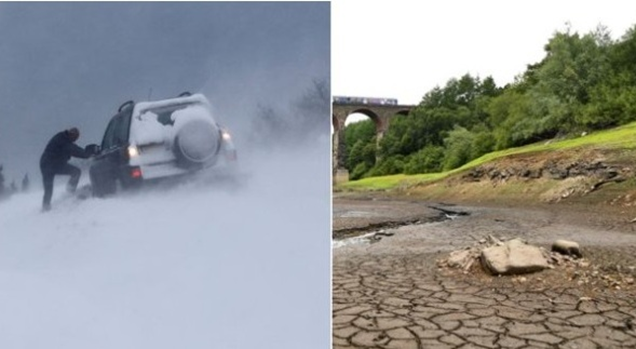Food Prices Across the Planet Upward Trajectory with No End in Sight

Starting off here over with the Australian government Agriculture Water Resources report the week of August 23rd.

You have a nice rundown on commodities, as well as where the drought areas are across Australia and country wide rainfall totals are far, far, far below normal, but they don’t want to outright come out and say “Hey, grain shortages because of extreme drought, once in a hundred and twenty year event.” The commodities that they have listed US wheat (Hard Red Winter), wheat up 26% year-on-year, I get a lot of people saying “Well, last week the prices were down.” Yeah, but look at the yearly total 26% up. Down through to the bottom section, there are milling wheat feed, wheat feed barley, this is Australia specific. Take a look at milling wheat prices up 63%, feed wheat up 85%, and what about barley an 86% increase, that’s just this year. As the drought intensifies these numbers are going to continue to increase, there are a lot of countries on the cusp of stopping their exports at the moment.

(BELOW) Looking at minimum temperature anomalies for the week, this are the lows, check these out. Well, below normal looks like the only place that’s not below normal is West Australia, but the media would have you believe it’s runaway global warming everywhere on the planet.

Staying within Australia domestic crop indicator prices, sorghum on the top left, barley on the top right, feed wheat, the red lines that’s this year pricing, up. Australia is kind of a canary in the coalmine for the rest of the planet, wheat production as well as grain output. They’re experiencing the drought first as well as South Africa, but the political upheaval going on down there is masking the crop losses. Because of the land confiscation going on down there, you’ll just say “well, it’s expected to go to zero for production” when people who don’t know how to farm, take over farms.

Jumping up to Europe, French wheat harvest 6.5% decrease, this is the lowest in the last ten years and expected to go lower as the harvest actually come in. Remember all that what we’re seeing in the northern hemisphere at the moment are purely forecasts.

Taking a look at US., number two Hard Red Winter Wheat red line is where we are, with today’s pricing again, it was up 26% this year alone.

To the UK, I am shocked to see BBC front page stating “food prices to rise 5% because of extreme weather”, the whole crux of the article is about consumer food cost increases. These are early warning signs.

I will the BBC him props, they actually talked about extreme cold as well as extreme heat both, they did show you the winter with the extreme late planting season, wet conditions and then it flipped right into drought.

The article continues, talking about the prices of wholesale vegetables soaring up to 80%, and the key takeaway from this article is second paragraph there the Center for Economics and Business Research (CEBR) explains that the increases will take 18 months to fully have an effect on shoppers. They’re giving you a timeline of when to expect maximum head-on collision with your earnings and food price increases. This is the zero mark here, you have 18 months. In my opinion the civil chaos unfurls, because people will not be able to afford food and these crop losses globally are going to intensify from this point forward.

Vegetable prices jumping 41% for onions, carrots 80%, butter 24%, meat price is also set to soar do to feed shortages. You already saw those massive increases down in Australia for feed wheat.


Another facet of this Grand Solar Minimum diamond, that we’re looking at here. This is a perfect example of economic effects when food prices rise, so the report goes on to talk about consumer costs and they put the extremely low number of 7 pounds per month per household.

When we take a look at how many households there are is almost 20 million households. Do the math on that, and then see how much money is going to be diverted into the food sector, which means people need to stop spending elsewhere. You need to ask yourself what’s the first thing people are going to stop spending on? Another sector of the greater economy is going to get slammed, and this is going to continue, this is one of the things that was talked about in the Maunder Minimum, the Dalton Minimum, and the Sporer Minimum. Every single Grand Solar Minimum the economy declines because people are spending all their money on food, now this year it’s 7 pounds per household, what happens when it turns into 28 pounds per household, and you could just work the math up from there.

Thanks for reading, hope you got something out of the article. If you like this type of information you can hear more with 30 minute segments in the tri-weekly podcast Mini Ice Age conversations available across the net.
*** Today’s Story Links ***
French wheat harvest, 6.5% decrease in 2018 year-on-year https://www.ccijf.asso.fr/ja/news-france-hebdo/5207-actu-france-2018-08-23-02
Food prices ‘to rise 5%’ because of extreme weather https://www.bbc.co.uk/news/business-45317023
Families and households in the UK: 2016 https://www.ons.gov.uk/peoplepopulationandcommunity/birthsdeathsandmarriages/families/bulletins/familiesandhouseholds/2016
Weekly Australian Crop Price Updates ABARES http://www.agriculture.gov.au/abares/Documents/climate-weekly/weekly20180823.pdf
Weekly Australian Climate, Water and Agricultural Update http://www.agriculture.gov.au/abares/publications/weekly_update
Australian Crop Report http://www.agriculture.gov.au/abares/research-topics/agricultural-commodities/

*** ADAPT 2030 Social Media Links ***
1.) PATREON www.patreon.com/adapt2030
2.) BITCHUTE https://www.bitchute.com/hashtag/adapt2030/
3.) STEEM https://steemit.com/@adapt2030
4.) *** ADAPT 2030 True Leaf Market Link ***

5.) Mini Ice Age Conversations Podcast
Libsyn: http://adapt2030.libsyn.com/
iTunes: https://itunes.apple.com/us/podcast/adapt-2030-mini-ice-age-conversations/id1200142326
6.) FB https://www.facebook.com/Miniiceage
7.) TWITTER https://twitter.com/adapt2030
8.) YOUTUBE www.youtube.com/user/MyanmarLiving

9.) MEDIUM https://medium.com/@globalcooling

@adapt2030, I gave you a vote!
If you follow me, I will also follow you in return!
I upvoted your post.
Cheers to you.
@Pinoy
Posted using https://Steeming.com condenser site.